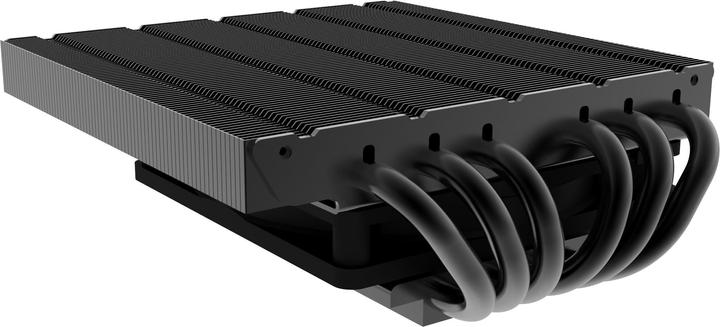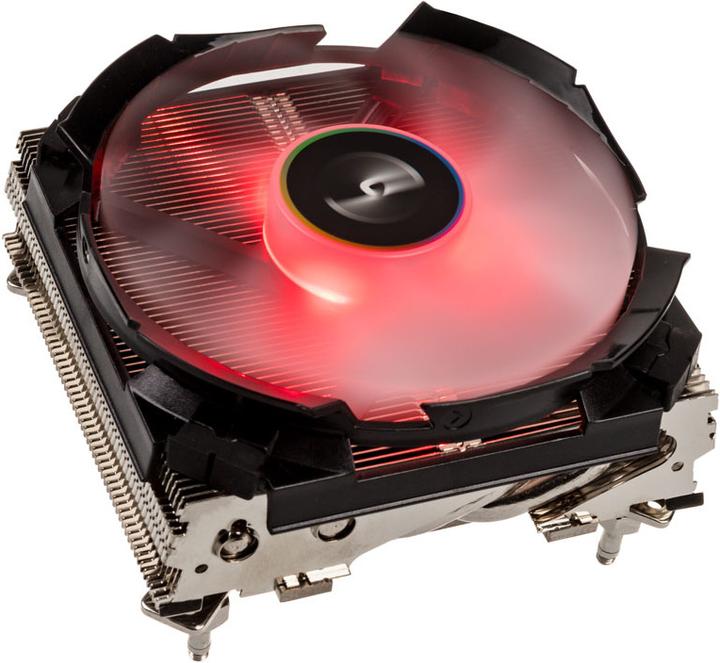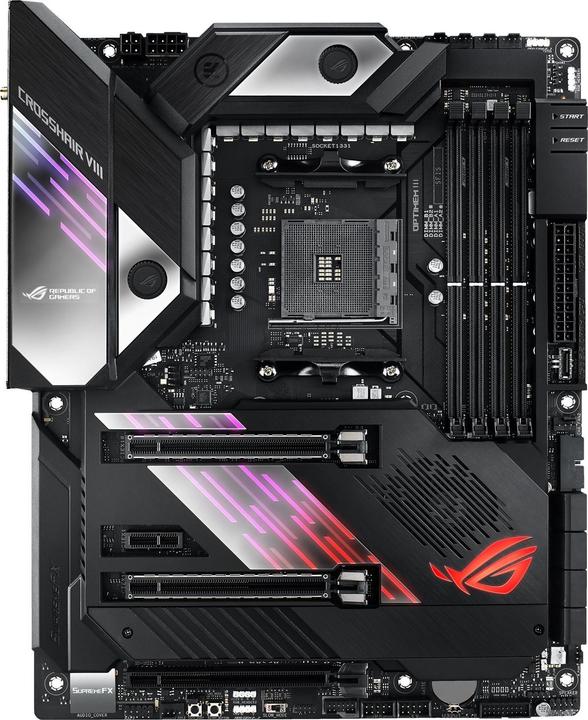

Which one cools best? Six top-down coolers in comparison
The demands on fans in small cases are high: they have less cooling surface and the airflow in a small space presents them with challenges. I bought and tested seven CPU coolers for small form factor builds.
The reader comment from EdenOfTheWest on my review of the Osmi 3.1 makes me look for the perfect cooler for future mini-ITX case reviews:

The comment is harsh. A comparison to The Verge's PC build? Seriously? That's the ultimate diss for a PC geek like me. A stab in the heart.
I disagree with him: powerful CPUs make sense in case tests because they push the cases and their airflow to the limit. And the Osmi only fits a graphics card with a maximum length of 17 centimetres. The 1660 Super that I have available for testing is the only one that fulfils these requirements. Anyway, there aren't many graphics cards under 17 centimetres and not many larger models anyway. In our shop, a 2060 Super is the highest of the 17-centimetre models. Where he is right, however, is in the choice of CPU cooler: there are larger coolers than the Noctua NH-L9a - the AMD version, I mistakenly linked to the Intel version in the article, which is why EdenOfTheWest calls it the NH-L9i - that fit into a case like the Osmi. I'm getting my act together and going in search of a better fan for future mini-ITX case reviews.
The requirements and the opponents
In most Mini-ITX cases, there is little space for a large CPU cooler. A cooler height of 70 millimetres is often the end of the line. You can forget tower coolers, you need a top-down cooler. I don't want to limit myself to 70 millimetres when testing, as the choice is very limited. With a bit of tinkering, it is usually possible to install fans up to 80 millimetres high. That's why I'm extending my search to coolers that don't exceed 80 millimetres. I choose seven of them in our shop that meet my criteria:
The coolers are all in stock at the time of testing. If you would like to have more coolers tested, write it in the comment column.
Fans behave differently in every case. That's why I don't test them in a case, but on our test bench. That way, all the coolers have the same conditions and I can see how they behave under optimum conditions. As I quickly realise, not all coolers fit on my Mini-ITX board. I'll explain the details below. That's why I'm doing the test on the ATX testbench with the following components:
The test CPU exceeds the cooling performance of most of the selected coolers. Nevertheless, the test makes sense: thanks to the powerful CPU, the differences in cooling performance are more clearly visible than with a weaker CPU.
Even on my ATX mainboard, not all coolers fit - I'll explain the details below. Thermal paste is included with every cooler. The Shadow Rock LP even comes with it already applied. However, I remove it and use Kryonaut from Thermal Grizzly for every cooler. So they all have the same conditions.
Noctua NH-L9a
The Noctua NH-L9a comes with its own mounting system. Even the original AM4 backplate is not used. With the NH-L9a, the cooler is screwed on from below. This is a little unusual, but is very easy.

The advantage of the NH-L9a: It should fit on all motherboards, as it is not really larger than the socket with a footprint of 92×114 millimetres. The cooler is very flat with a height of 37 mm. This means it also fits on my ASUS ROG Strix X570-I Gaming mini-ITX test motherboard. However, it is important that you buy the correct version: There is a separate variant for AM4. The supplied NF-A9x14 fan rotates at a maximum of 2500 rpm.
Noctua NH-L9x65 SE-AM4
The NH-L9x65 SE-AM4 also comes with its own mounting system - but with the one I'm familiar with, which uses the original AM4 backplate. I don't find Noctua's system ideal, as the two screws for mounting don't always grip straight away. This probably only bothers me, who regularly screws them on and off for testing. As a rule, you mount the cooler once and that's it.

As with the NH-L9a, the footprint of the NH-L9x65 SE-AM4 is roughly the same size as the socket: 95×95×65 millimetres. So it should fit on any motherboard. It also fits on my Mini-ITX test mainboard. Again, be careful when buying the cooler: There is a separate version for the AM4 socket. The NF-A9x14 fan is the same as the NH-L9a.
Scythe Big Shuriken 3
The Big Shuriken 3 has its own mounting system that uses the original backplate. In contrast to the Noctua models, the Big Shuriken 3 has mounting options for all standard consumer sockets. However, they are mixed up in a single package. So you have to pick out the parts you need first. The mounting system is similar to the NH-L9x65. However, I find assembly easier because everything is more accessible.

The cooler fits on my X570 Mini-ITX mainboard, but the distance to the graphics card is very tight. If I want to change the graphics card with the fan fitted, I have to remove either the RAM or the cooler, as I can't get to the mechanism to detach the graphics card. The dimensions: 122×122×69 millimetres. The cooler can be mounted vertically in two directions. Due to the VRM heat sinks, I can only mount it facing downwards. The supplied fan rotates at up to 1800 rpm.
Cryorig C7 RGB
The C7 also uses its own mounting system. Like the NH-L9a, the cooler is screwed on from below. It is compatible with all common consumer sockets. The cooler has RGB. However, you can only enjoy this if you connect the separate 12 V cable to the mainboard or power supply unit.

The cooler should actually fit on all standard boards due to its dimensions of 97×97×47 millimetres. But it doesn't. The cooler is too low-profile for my Mini-ITX board. As a result, it rests on the chipset holder instead of directly on the CPU. It can be mounted vertically in two directions. The supplied fan rotates at a maximum of 2500 rpm.
bequiet! Shadow Rock LP
The mounting system of the Shadow Rock LP uses the original backplate. In contrast to the Big Shuriken 3, the mounting material is neatly separated by base. Assembly is tricky because it requires a lot of dexterity and the instructions are not entirely clear.

The cooler is rather on the large side at 122×134×75.4 millimetres. It doesn't fit on my X570 Mini-ITX mainboard, although it can be mounted horizontally in two directions. It bumps against the I/O connections. The supplied fan rotates at a maximum of 1500 rpm. Whether the Shadow Rock LP will fit on your Mini-ITX board is something you'll have to try out or look at the manufacturer's list. Although you can't always rely on them: According to the manufacturer, the C7 and the Black Ridge should have fitted my Mini-ITX board. So you have no guarantee that it will fit.
Cooler Master Masterair G100M
The Masterair G100M's own mounting system must first be customised for the respective socket. The system is cumbersome and the instructions are not entirely clear. Some skill is required when mounting the heat sink. The screws for tightening are difficult to access. The G100M has RGB, but this requires a separate 12 V connection.

The Masterair G100M looks huge. Despite its 145×145×74.5 millimetres, it fits on my X570 mainboard. This is due to its shape, which is narrow at the bottom and widens towards the top. However, be careful with high-rise RAM: the cooler will bump into it. The supplied fan rotates at a maximum of 2400 rpm.
Alpine hairdryer Black Ridge
Unfortunately, the Alpenföhn with its 140×120×47 millimetres does not fit on either my Mini-ITX board or my ATX board. The large one rests on the VRM heatsink, the small one on the I/O connectors. That's why this is the last thing you'll read about it.
Test and results
For the stress test, I run HeavyLoad for 20 minutes. The programme loads all of the CPU's cores to 100 per cent. I use HWiNFO64 to record the temperatures of the CPU, chipset and RAM as well as the CPU clock frequency. If you're wondering why I'm leaving out the VRM: The test motherboard doesn't have a sensor there. I leave the fans set to standard in the BIOS. This means they turn up fully from 70° Celsius.
This is how the six fans perform:

Except with the Shadow Rock LP, the CPU reaches its thermal limit of 95° Celsius with all fans. The Shadow Rock LP looks like the sure winner, and purely from an efficiency point of view, it is. Unfortunately, it doesn't fit on my Mini-ITX mainboard. So I won't be able to use it for my mini-ITX case reviews in the future. Will it fit on your mini-ITX board? You would have to try it out or look at the list of manufacturers.
When it comes to the other coolers, there is no winner in terms of temperature alone. It is therefore worth taking a look at the clock frequencies:

The CPU starts with 3768.2 MHz on all cores with all coolers. With the Shadow Rock LP, the CPU is able to keep the clock constantly above 3900 MHz during the test at a maximum of 90.2° Celsius. The cooling performance has a striking effect on the clock frequency in this test. With the C7 RGB, the CPU clocks around 500 MHz less quickly after twenty minutes. But even with the two Noctuas, the clock frequency drops relatively quickly by up to 200 to 250 MHz. The G100M and the Big Shuriken 3 can at least maintain the original clock rate to some extent.

The Shadow Rock LP also performs best in terms of volume. It produces only 42 dB of sound under full load. The C7, which cools most inefficiently, is also the loudest cooler: My sound level meter shows 50.5 dB. The two Noctuas come in at 46.5 dB (NH-L9a) and 47 dB (NH-L9x65). The Big Shuriken 3 is slightly louder at 48.5 dB and the G100M is almost as loud as the C7 at 50 dB.


The Shadow Rock LP again achieves the best result for chipset and RAM temperatures, but the C7 is the second best performer. The fan of the C7 apparently generates a good amount of airflow, which also benefits the chipset and RAM. The two Noctuas perform worst here. The Big Shuriken 3 is in the middle of the field. Unfortunately, I don't have a comparative value for the G100M, as I use low-rise RAM instead of the high-rise RAM in the other coolers. This is because the cooler wouldn't fit otherwise.
Conclusion: Shadow Rock is clearly ahead
bequiet! is the clear test winner with the Shadow Rock LP. Unfortunately, the cooler doesn't fit on my mini-ITX mainboard. For future mini-ITX case reviews, I will therefore be focussing on number two: the Big Shuriken 3 from Scythe. The CPU runs at its limit, but at least it can maintain the original clock rate for a certain amount of time.
I'm disappointed with the Noctua NH-L9x65, which doesn't really achieve better values than the NH-L9a despite the larger heat sink. It's obvious that the C7 RGB doesn't achieve such good values due to the size of the cooler. The result of the NH-L9a is all the more respectable. So user EdenOfTheWest wasn't quite right. Sure, there are better fans than the NH-L9a for my reviews, but there are definitely worse ones as well.
From big data to big brother, Cyborgs to Sci-Fi. All aspects of technology and society fascinate me.














